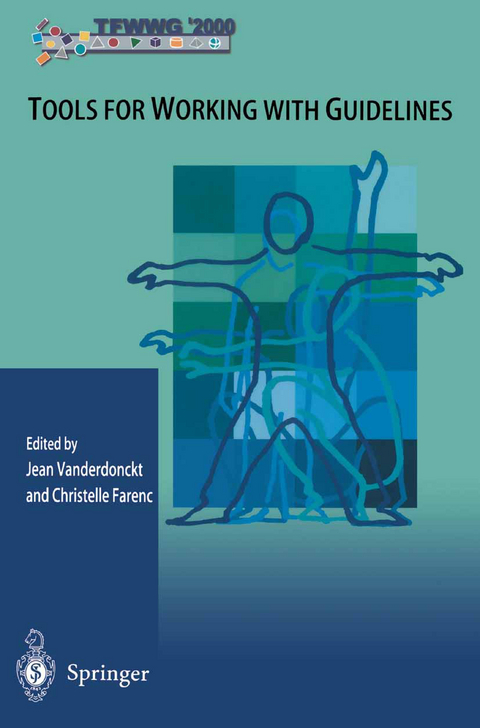
Tools for Working with Guidelines
Springer London Ltd (Verlag)
978-1-85233-355-3 (ISBN)
This volume contains the papers presented at the International Workshop on Tools for Working with Guidelines, (TFWWG 2000), held in Biarritz, France, in October 2000. It is the final outcome of the International Special Interest Group on Tools for Working with Guidelines.
Human-computer interaction guidelines have been recognized as a uniquely relevant source for improving the usability of user interfaces for interactive systems. The range of interactive techniques exploited by these interactive systems is rapidly expanding to include multimodal user interfaces, virtual reality systems, highly interactive web-based applications, and three-dimensional user interfaces. Therefore, the scope of guidelines' sources is rapidly expanding as well, and so are the tools that should support users who employ guidelines to ensure some form of usability.
Tools For Working With Guidelines (TFWWG) covers not only software tools that designers, developers, and human factors experts can use to manage multiple types of guidelines, but also looks at techniques addressing organizational, sociological, and technological issues.
Invited Speakers.- 1. RealPlaces, 3D Interfaces for Office Applications.- 2. A User Centered Design Based Approach to Style Guides.- Guidelines for Universal Design.- 3. A Laboratory of Ergonomic Analyses for Children Suffering from Cerebral Palsy.- 4. Design Criteria of a Handbook for Web Accessibility.- 5. Checking W3C WAl User Agent Guidelines against Browsers Following UI4All principles.- 6. Guidelines for Developing Assistive Components for Information Appliances — Developing a Framework for a Process Model.- Software Tools for Working with Guidelines.- 7. A Database Approach to Building and Using Online Human Computer Interaction Guidelines.- 8. Sherlock: A Tool Towards Computer-Aided Usability Inspection.- 9. Completing Human Factor Guidelines by Interactive Examples.- 10. A Generic Approach in Automating Style Guide Tests.- Guidelines in Industrial Contexts.- 11. Approaches to the Evolving Human-Computer Interface: Application to Interactive Computerized Procedures in High-Risk Industries.- 12. A Questionnaire-based Discount Evaluation Method using Guidelines for Process Control Interactive Applications.- 13. An International Standard on Control Center Ergonomics under Development.- Incorporation of Guidelines into Methods.- 14. Incorporating Human Factors into a Method for Designing of Adaptive User Interfaces.- 15. Implementation Support of Guidelines through Directed Evaluation and Re-engineering.- 16. Applied Heuristic Evaluation in the System Development Process.- Organizational, Commercial, and Social Aspects of Guidelines.- 17. A Sociological Framework for Groupware Design-Guidelines.- 18. Making Guidelines Work through Collaboration: Integrating Standards and Guidelines into Software Development Lifecycle.- 19. Difficulties in Using Style Guides forDesigning User Interfaces.- 20. The Use of USERfit Methodology to Teach Usability Guidelines.- 21. Towards a Library of Generic Guidelines for Specifying Multi-Threaded Dialogs.- Guidelines in Software Engineering.- 22. Tools for Working with Guidelines in Different Interface Design Approaches.- 23. Use of Formalized Guidelines for Semi-automated Generation of GUI: the Ergo-Conceptor+ Tool.- 24. A Small Knowledge-based System for Selecting Interaction Styles.- 25. Software Engineering in User Interface Design with Guidelines-from Traditional Applications to the Web Sphere-.- Guidelines and Evaluation Methods.- 26. A Tool for Evaluation using Dynamic Navigation in a Set of Questions.- 27. Proposing Guidelines for Usability Inspection.- 28. Transferring Knowledge of User Interfaces Guidelines to the Web.- 29. Theories, Models and Templates: A Harmonious Trilogy for the Propagation of Guidelines.- Special Topics in Guidelines.- 30. Patterns as Tools for User Interface Design.- 31. A Comparative Usability Study of Electronic Newspapers.- 32. Guidelines for a ’Proximal’ User Interface.- 33. How do Users Perceive Applying Web Design Guidelines?.- Author Index.
| Erscheint lt. Verlag | 4.10.2000 |
|---|---|
| Zusatzinfo | IX, 373 p. |
| Verlagsort | England |
| Sprache | englisch |
| Maße | 155 x 235 mm |
| Themenwelt | Mathematik / Informatik ► Informatik ► Betriebssysteme / Server |
| Informatik ► Software Entwicklung ► User Interfaces (HCI) | |
| Mathematik / Informatik ► Informatik ► Theorie / Studium | |
| ISBN-10 | 1-85233-355-3 / 1852333553 |
| ISBN-13 | 978-1-85233-355-3 / 9781852333553 |
| Zustand | Neuware |
| Haben Sie eine Frage zum Produkt? |
aus dem Bereich


